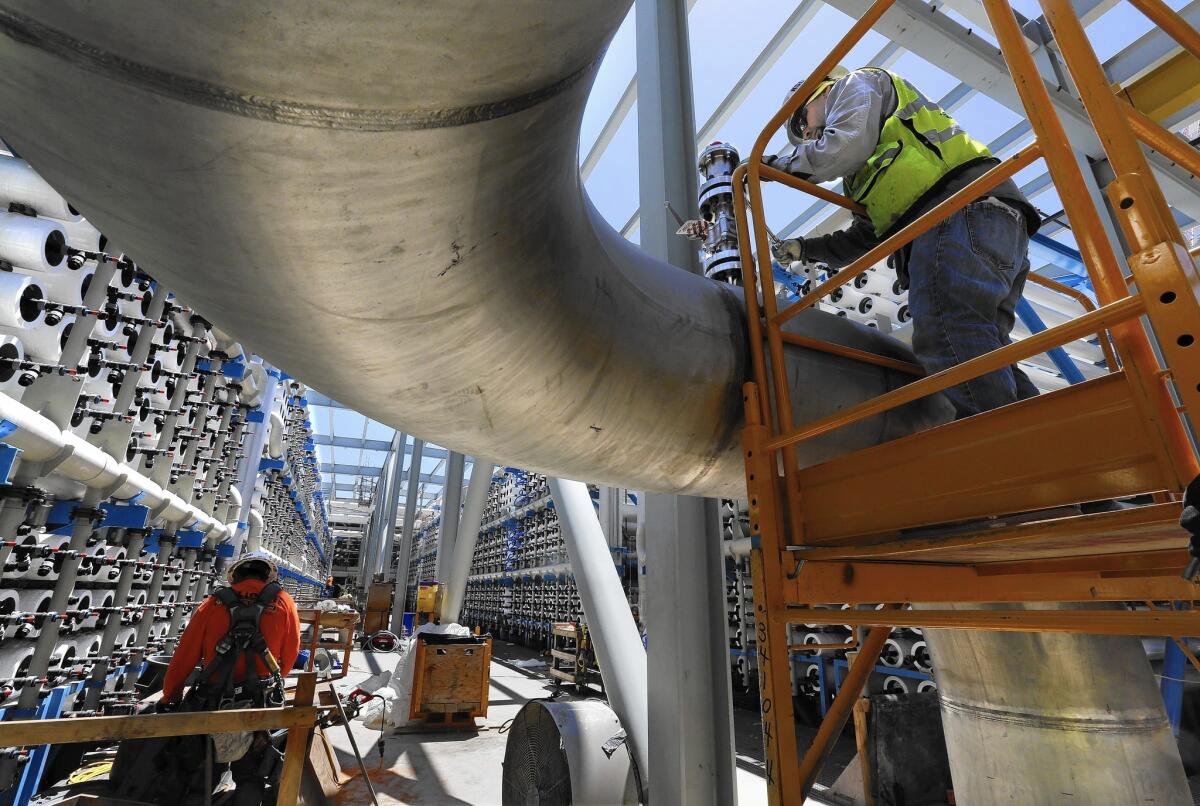San Diego is a salt mover and shaker in desalination campaign

Reporting from San Diego — San Diego may be known as “America’s Finest City,” but — at least this week — it’s also the epicenter of the desalination and water reuse movement.
More than a thousand water experts from around the globe are gathered at the waterfront convention center for the International Desalination Assn. World Congress.
The area had one of the first desalination plants — opened in Point Loma in 1961 — and will soon see a $1-billion facility open in Carlsbad.
With the state gripped in drought, “we’re increasingly the city that embraces ideas to secure our water future.… Here in San Diego, we’re taking matters into our own hands,” Mayor Kevin Faulconer told the assemblage.
On Thursday, experts from Australia and Singapore, and an American consultant to countries in the Middle East, discussed how those areas have coped with weather and technology problems similar to California’s, and offered some advice.
Among their suggestions:
• Don’t quit if El Niño brings a bumper crop of rain. Convince the public that a day or month of rain doesn’t end a drought.
More to Read
“We maximize the media effect … to reinforce the message to the public,” said Tiing Liang Moh, an official with Singapore’s national water agency.
• Remind the public that desalination and other water projects cost money but that the cost of drought is even higher.
The Australian public responded well when shown that the cost of a badly needed desalination project was about the same as one beer per week, said Neil Palmer, chief executive of Australia’s National Centre of Excellence in Desalination.
• Don’t get too comfortable with one kind of technology. If something better and cheaper comes along, adapt quickly.
The Saudis ran desalination plants for decades with thermal power — boiling out the salt. Then came improved membrane technology for reverse osmosis and the Saudis shifted, said Kevin Price, a former U.S. Bureau of Reclamation official and currently a consultant in the Middle East.
Now the Saudis are building what is billed as the world’s largest desalination project to be run on solar power, said Abdullah Al-Alshaikh, president of the International Desalination Assn.
• Avoid the temptation to think of converting seawater to fresh as the silver bullet. Even when the Carlsbad project is running, it will provide only 7% to 10% of the region’s water.
• Avoid the “yuck factor,” a term used by Palmer and Moh. People recoil at drinking water that once was in the toilet, despite scientists swearing it’s perfectly clean.
In San Diego, a project was doomed by the term “toilet to tap.” Moh said Singapore has a better term: “Indirect potable use of recovered water.”
• Mobilize the public during times of maximum need.
“With the political will and a major crisis, a lot can happen in a short period of time,” Palmer said. Singapore, Moh said, retains a “siege mentality” on water issues.
• Don’t stop telling the public that the days of unlimited water are over. “Tell them to look at the bigger picture,” Al-Alshaikh said.
Douglas Eisberg, director of business development at Avista Technologies in San Marcos, and a board member of the International Desalination Assn., said he appreciated all the advice, particularly about not getting complacent when it rains.
“I’m very worried about that,” he said. “We just have such a tendency to put things off, to say, ‘We don’t need to do anything now.’”
Lani Lutar, former chief executive of the San Diego County Taxpayers Assn., said that a sustainable water future depends on two things: “political leadership and public engagement, whether it’s desalination or reuse.”
“Technology is not the issue,” she said. “The technology is here, and it’s rapidly advancing. We just need to use it.”
Before departing for their home countries, conventioneers on Friday are scheduled to tour the Carlsbad plant and a proposed plant in Huntington Beach.
Fourteen years in the making, the Carlsbad plant is the pride of local officials — proof that the region is “aggressively seek[ing] new water sources as we conserve all existing supplies,” said Mark Weston, board chairman of the San Diego County Water Authority.
Among the conventioneers, anticipation of Friday’s visit created a buzz.
“Carlsbad could be the model for the future,” Al-Alshaikh said.
Twitter: @LATsandiego
Sign up for Essential California
The most important California stories and recommendations in your inbox every morning.
You may occasionally receive promotional content from the Los Angeles Times.









